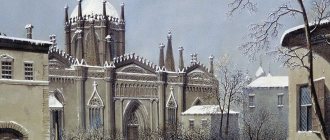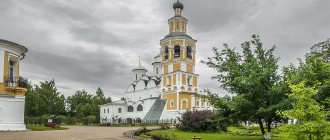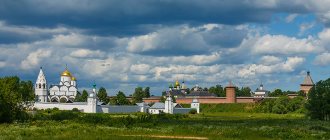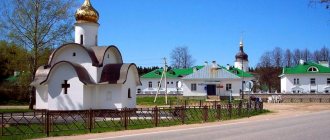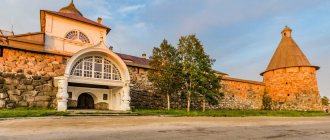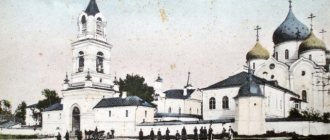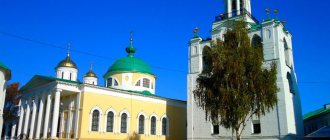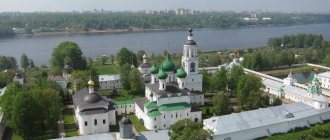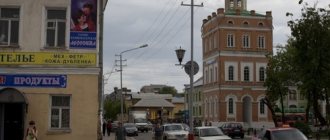July 10, around 16:00, rain. We go to the Spaso-Euphrosinievsky Monastery. I’ll tell you about his story below, but for now just my impressions. We enter the entrance gate made in a six-meter wall.
We enter a courtyard planted with roses and thujas. Very beautiful. And what’s surprising is that there is no rain in the yard! Well, that is, the yard is wet, but from above, from the clouds, there is no dripping.
Before us appeared the beautiful Holy Cross Cathedral with five helmet-shaped black domes.
We're approaching... And whoa! You can't use phones, cameras, or cameras. We've arrived. I photographed what was visible from the street. A little. Therefore, for the history of the monastery, I took photographs from the Internet.
Cross of Euphrosyne of Polotsk
A unique work of applied art of this time is the cross of Euphrosyne of Polotsk. The cross is considered the most important symbol of Christianity, which expresses the highest sacred values: the ascension of the spirit, the desire for God, eternity, and is a model of existence and man in it.
By order of Euphrosyne in 1161, Lazar Bogsha created the Cross-ark to store Christian relics sent from Constantinople and Jerusalem. The master made the altar cross six-pointed. Its shape symbolizes the Universe created by God in six days.
The basis of the cross was cypress wood, from which especially valuable religious objects were made. The relic measures 51.8 cm in height, the length of the top crossbar is 14, the bottom is 21, the thickness is 2.5 cm, the top and bottom of the tree were covered with 21 gold plates with precious stones, ornaments and 20 enamel plates representing the faces of saints.
At the upper ends of the Cross, the master placed half-length images of Christ, the Virgin Mary, and John the Baptist. In the center of the lower crosshair are images of the four evangelists John, Luke, Mark and Matthew, and at the ends are the archangels Gabriel and Michael. Below are the heavenly patrons of Euphrosyne and her parents - Euphrosyne of Alexandria, George and Sophia.
On the reverse side of the Cross there are images of the church fathers John Chrysostom, Basil the Great, Gregory the Theologian, the Apostles Peter and Paul, as well as Saints Stephen, Demetrius and Panteleimon.
Above each icon there are inscriptions in Greek and Slavic letters. In the middle of the Cross, in five signature square nests, there were Christian relics: pieces of the Cross of the Lord with drops of the Blood of Jesus, a piece of stone from the Tomb of the Virgin Mary, pieces of the relics of Saints Stephen and Panteliimon and the blood of Saint Demetrius.
The sides of the Cross are lined with 20 silver plates with gilding, and along the perimeter of the front side of the Cross there is a pearl outline. The most valuable of the Christian relics placed in nests are pieces of the Holy Tree - the Cross on which Christ was crucified.
According to the customer’s plan, this shrine should forever “give life” to the souls of Polotsk residents and all believers. In terms of its execution technique, the Cross is a masterpiece of world significance, one of the few dated monuments of applied art of the 12th century.
The history of the emergence of the Spaso-Efrosinyevsky Monastery in Polotsk.
The Church of the Savior Euphrosyne
is a very valuable building for Belarus, since it is the only one among the ancient Polotsk monasteries that has survived to this day. It is the largest center of Orthodoxy throughout the country.
The monastery was founded in 1125
year Princess
Euphrosyne
, in whose honor it received its modern name. Initially, the temple was a small wooden structure. But over time, the number of young nuns grew, and this wooden building became not enough. There was an urgent need to build a new monastery of a larger size. The resulting building was built of stone in exactly 30 weeks thanks to the architect John.
For 45 years, Euphrosyne lived at the monastery. During this period, the temple became the main place of education for the land of Polotsk. In those days there was a very large library at the monastery and an actively working workshop for painting icons, as well as a small parish school.
Features of the monastery in Polotsk.
Today Spaso-Evfrosinievsky
The temple
is known
as the best preserved among other architectural monuments of Polotsk. Since the existence of the monastery, its owners have changed very often; it passed from one hand to another every now and then, and only in the first half of the 19th century was it returned to the Orthodox. After this, a new period of active development began for the temple. The building was completely restored, and the women's religious school at the monastery resumed its work again. At the same time, the Cross of Euphrosyne, which she had donated to the temple, returned to the walls of the monastery.
Sad times replaced the vigorous activity of the temple in the post-revolutionary period. Already in 1921, the Euphrosyne convent was closed and the Cross was requisitioned. Even the relics of the saint were opened and they were sent to Moscow for an atheistic exhibition.
In 1943 the relics
The saints were
returned
to the walls of the temple, and the monastery continued its active work until 1960. After which the church was closed again. The temple opened its doors to its parishioners only in 1989.
Cross
, which was so dear and valuable for the Church of the Savior Euphrosyne, has never been found to this day.
The last mention of it was during the Patriotic War. copy of the Cross of Euphrosyne
was made by one of the experienced Brest jewelers. This product was donated to the monastery, and we can see it within the walls of the temple today.
Loss of the cross
This miracle of craftsmanship and beauty became a sign of Divine patronage over Belarus, a symbol of the high spirituality of the Polotsk land. History of the Cross in the 20th century. filled with detective content.
In 1921, the Cross was requisitioned by the Soviet authorities; for some time it was in the Minsk museum, but already in 1929 it was transported to Mogilev. On November 21, 1929, an act was drawn up for the transfer of Lazar Boschi’s creation from the Minsk Museum to the Mogilev Museum.
In Mogilev, the shrine was placed in a museum exhibition, but visitors prayed near the Cross. For this reason, it was transferred to the former land bank. According to the official version, it was from here that he was stolen by the Nazi invaders in 1941.
There are other versions. As if the Cross came to the east and that it was sold after the war at an auction overseas. The search for this Cross was carried out more than once; they searched in Europe, America, in the collections of Morgan and Rockefeller; diplomatic services, famous Belarusian scientists, and Interpol specialists were involved in the search. But the Cross has not yet been found.
See the sights of Polotsk with a guided tour.
Bow down
Anyone can visit the relics of the saint; people from all over the country and neighboring countries come here. Tourist and pilgrimage tours are organized to the Euphrosyne Monastery, which help travelers get closer to the cultural and historical places of Belarus.
The Savior Euphrosyne Church is a shrine, inspection and visiting of which is included in the program of every excursion tour to Polotsk. You can see the sights of Polotsk both during the sightseeing tour “Patriarch of the Belarusian Land” and by joining one of the group bus tours around Belarus. You will be able to see the monastery of Euphrosyne, which includes a whole ensemble of buildings for various purposes: the Church of the Transfiguration itself, the Cathedral of the Exaltation of the Cross, a refectory, a bell tower, the remains of the foundation of a tomb, a residential building and several utility rooms.
Story
This temple appeared a long time ago, in the distant twenties of the twelfth century. It was then that Princess Predslava founded the Spaso-Efrosinievsky Monastery, which was named in her honor. Better known as Euphrosyne of Polotsk, this very intelligent woman was the granddaughter of the legendary Vseslav the Magician. Her mother came from an equally famous family: she was the daughter of Vladimir Monomakh. Of course, with such a brilliant pedigree, the young princess had a brilliant future in the world. Therefore, when their daughter was barely twelve, her parents began to think about finding a worthy husband. However, the little princess, distinguished by her strength of character, made her own, completely different decision: the girl wanted to become a nun. Her parents failed to dissuade Predslava: she secretly escaped from her father’s house and took monastic vows in one of the Polotsk monasteries, where her own aunt was the abbess. The girl received a new name: she was named Euphrosyne.
Many years later. Euphrosyne, with the permission of the Bishop of Polotsk, settled in one of the cells in the St. Sophia Cathedral. She, according to chroniclers, rewrote and sometimes translated books. Somewhere in 1124, the nun was given a small plot of land from the bishop, located in the vicinity of Polotsk. Here she decided to build a monastery.
Legend
This decision of Euphrosyne did not come by chance. According to legend, Bishop Ilya of Polotsk had a prophetic dream in which an angel allegedly ordered the nun Euphrosyne to found a monastery at the Church of the Savior. The saint herself saw a similar dream, not once, but three times. This is exactly how it was decided to build a monastery, which today is called the Spaso-Efrosinyevsky Monastery (Polotsk).
The temple stands on the very bank of the Polota. It was erected on the site where the wooden Church of the Savior stood. The first nuns who moved here were the sisters and cousins of Euphrosyne herself. And soon women from all over the country began to come to the Spaso-Ephrosyne Monastery.
Values
In 1899, the Spaso-Efrosinievsky Monastery underwent another reconstruction: a majestic cathedral was erected on the territory of the complex. During the war, a camp for Soviet prisoners was organized here. At this time, many buildings in the complex were destroyed. And only after the liberation of Belarus the monastery became operational again. At the end of the Great Patriotic War, fifty nuns already lived here. They lived in a large two-story house and farmed three hectares of land. The abbess regulated the daily routine of those whom the Spaso-Ephrosyne Monastery accepted under its roof. The nuns sewed blankets for the residents of Polotsk, grew vegetables, and did handicrafts.
Difficult years
The history of the Spaso-Efrosyne Monastery knows both good and bad times. In 1579, the monastery became the residence of Emperor Stefan Batory, the king, who subsequently handed it over to the Jesuits. They, in turn, began to rebuild the building. When Polotsk was captured by Russian troops in 1656, Tsar Alexei Mikhailovich returned the monastery to the Orthodox, but not for long. In 1667, the temple again passed to the Jesuits. This endless change of owners ended only in 1832, when the monastery finally went to the Orthodox. And since 1841 it has been for women.
Restorations
The appearance in which the Spaso-Ephrosyne Monastery has come down to us was greatly distorted by numerous reconstructions. Although, in fairness, it should be said that these changes did not affect the ancient masonry. Research by many architectural historians, for example, Rakitsky, Rappoport, Shtender and others, makes it possible to restore the original appearance of the temple with extreme accuracy. They managed to accurately recreate one of the main elements that form the unique appearance of this church, dating back to the twelfth century. We are talking about a double row of keel-shaped three-bladed kokoshniks framing the faceted drum of the monastery, topped with a helmet-shaped dome. There is no doubt that the builders who erected the Spaso-Ephrosyne Monastery in the twelfth century had quite a lot of technical knowledge. This confirms the excellent quality of the brick plinth, the cleanliness of the masonry and the composition of the lime mortar.
Description
The peak of active construction occurred in the period from 1133 to 1143. Then the brother of the Venerable Euphrosyne sat on the Polotsk throne. The architecture of the temple combines several directions, in which the influence of various schools is visible. The Spaso-Efrosinievsky Monastery itself, a photo of which is proof of its ascetic beauty, is a six-pillar, three-nave, single-dome structure, covered with vaults and supported wide arches. It has a narthex, as well as choirs located on the second floor, to which a narrow staircase leads inside the wall.
On both sides of the choir there are two cross-shaped very close cells. In one of them, according to church records, the Venerable Euphrosyne herself was in prayer, and in the other the saint’s relatives, nuns Evdokia (her sister) and Eupraxia (cousin), prayed. The cells are made like tiny side-cross-domed churches. Moreover, one of them (the southwestern one) is closed with a small dome, and the second one, the northwestern one, is covered with a cylindrical vault.
Where is the monastery
The monastery is two hundred and twenty-seven kilometers away from Minsk. Getting there is easy: at the twenty-second kilometer of the Moscow Ring Road you need to turn towards the village of Ostroshitsky Gorodok. From there you need to get to Pleschenitsy (forty-five kilometers), then turn towards Polotsk. The journey will take several hours.
It’s easy to find your way around Polotsk itself. Euphrosyne of Polotsk Street leads from the city center to the monastery. It is almost impossible not to see the gate with the bell tower. Not far from the monastery itself, two hundred meters from it on the right, there is a parking lot where you can leave your car.
